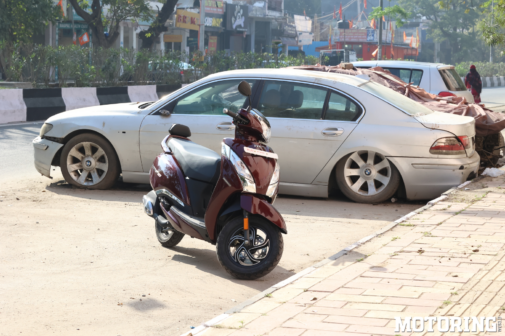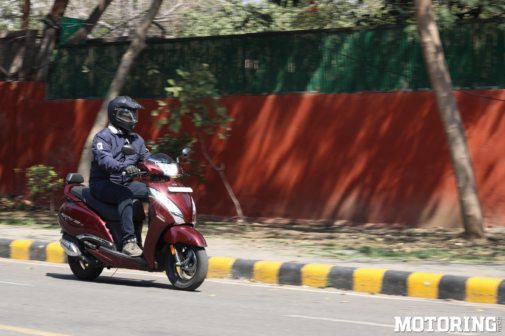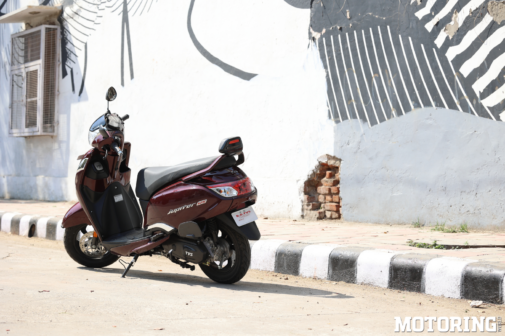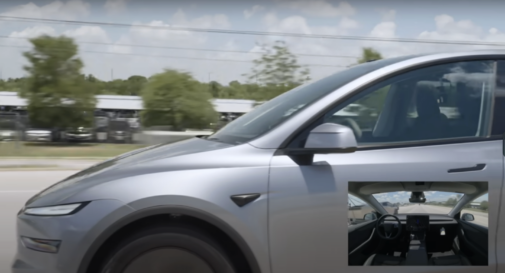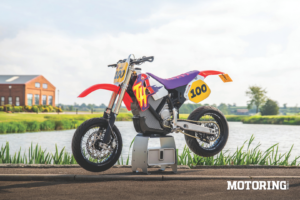I once wrote about how scooters have evolved over the years, which you can find on our website, but let’s stick to the point. The other day, while riding the Jupiter 125 SmartXonnect back home from work, I happened to receive a phone call, and thanks to its app connectivity, I could see who was calling. To think of a few decades ago, the best we got was a small pod on the handlebar.
So what’s new on the TVS Jupiter 125 SmartXonnect? The semi-digital cluster has been replaced by a fullydigital unit. Turn the key and if you’ve signed up/registered on the app, the scooter will immediately greet you with a welcome message along with your name. Once the app is connected via bluetooth, the cluster then displays things like the latest cricket/football scores, weather updates, social media notifications, battery voltage, average fuel consumption with DTE, and amount of CO2 saved as well. While weather updates and call alerts can be somewhat useful, on the road you just cannot afford to have distractions such as cricket scores and social media notifications.
Enabling navigation is an affair that requires turning the scooter and the app on and off multiple times. The navigation system is backed by MapMyIndia, which isn’t really perfect most of the time, but strangely enough, I had to keep my phone turned on throughout the ride, in order to get the right directions, lest it be stuck with the same arrow. I couldn’t really figure out if this was a problem with my phone or a general problem with the app/scooter itself. Nevertheless, if you don’t need navigation, you can always switch the tachometer on, which does look quite good.
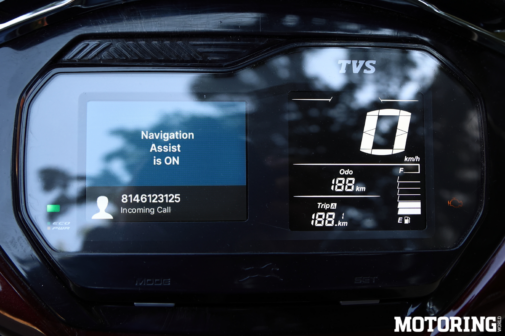
On the road, the Jupiter 125 feels quick and agile, and it catches up with traffic rather easily. To remind you, the 125cc engine used here is different from the one on the Ntorq. The acceleration from standstill is strong, and it reaches 70 kph in no time. After that, it takes time to reach 92 kph, and I suspect it could reach marginally higher speeds but I ran out of road at that moment. There is a certain buzz that can be felt on the seat at 4100 rpm, but other than that, things remain vibe-free for the most part. Even at high speeds, the mirrors continue to offer a good view of what’s behind. The exhaust note has some gruffness to it, which will either be appreciated or go unnoticed by the target customer. As an enthusiast, I certainly enjoyed it.
TVS has done a good job with the ergonomics; the seat upholstery feels exactly right, and it is long and wide enough to accommodate two people with a healthy build. I am 5 ft 6 in tall, and while the height of the handlebar felt perfect for me, my 6 ft tall brother-in-law found his knees fouling with the handlebar at u-turns. I didn’t spend much time as a pillion, but I did appreciate the addition of a back rest when the opportunity presented itself.
The trump card of the Jupiter 125 (and the 110) is the suspension. It offers you a very comfortable ride; whether you’re facing potholes, speed breakers, road undulations, or even rutted roads, the Jupiter 125’s suspension just doesn’t let you feel a thing and it just rides smoothly. Full marks here to the telescopic forks and the preload-adjustable monoshock setup, although I didn’t need to tweak the latter at all. The 12-inch wheels on both ends also further help its case.
With the fuel tank moved below the footwell, there’s enough space for a baby to sleep in there (not that we’d recommend it). However, what I find particularly strange is that the storage space features no illumination, considering that the Hero Destini gets it. That said, it does score back points with the follow-me headlamp function, which certainly helps if you’re getting home after dark and your parking spot is poorly-lit.
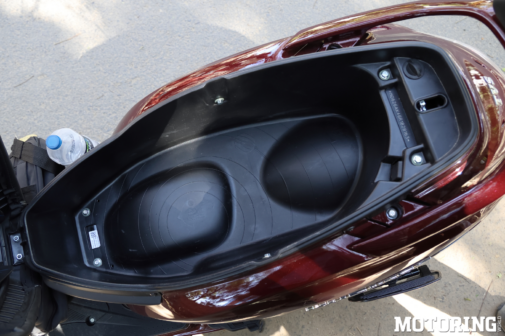
To sum it up, the Jupiter 125 SmartXonnect is decently quick, comfortable, and it packs in a few useful features as well. Yes, the app does need multiple attempts for navigation to connect, but it’s better than having no help from the instrument cluster at all (looking at you, Honda and Yamaha). You could just opt for the standard disc variant instead, but then you’ll miss out on the newer cluster which looks and feels superior, even if app connectivity isn’t the best. Bottom-line, whether you opt for the standard disc variant or the SmartXonnect, you’re getting yourself a premium scooter that’s very comfortable and practical.
MOTODATA
TVS Jupiter 125
POWERTRAIN
Displacement:
Max Power:
Max Torque:
Transmission:
124.8cc, single
8.2 bhp@6500 rpm
1.07 kgm@4500 rpm
CVT
CHASSIS
Type: Underbone tubular
SUSPENSION
F/R: Telescopic hydraulic/pre-load adjustable monoshock
BRAKES
F/R: 220-mm disc / 130-mm drum
TYRES
F/R: 90/90 R12 / 90/90 R12
DIMENSIONS
L/W/H (mm):
Wheelbase:
Ground Clearance:
Seat height:
Kerb Weight:
Fuel Capacity:
1852/681/1168
1275 mm
163 mm
790 mm
108 kg
5.1 litres
PRICE
Rs 96,855 (ex-showroom, Delhi)










